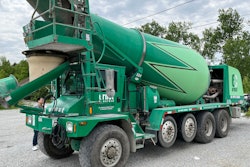
Like a doctor checking a patient for symptoms, a rental fleet manager can tell a lot about a machine's health by the state of its tires. Recognizing key types of wear and damage can be extremely helpful with avoiding costs or hazards in the future and determining the best tire for a replacement.
Abrasion and Wear
Some damage is unavoidable, including regular tire wear. What we call "rubber" on a tire is actually "compound," or a blend of a dozen or more ingredients—natural and synthetic rubber are just two of them. Other constituents of compound include silica and carbon black for wear resistance, a wide range of polymers and elastomers for flexibility, polybutadiene to reduce heat buildup, sulfur to crosslink the compound's molecules, zinc oxide to help cure the compound in the heated mold, and others.
Compound engineers make minute adjustments in the recipe for different parts of each tire, trading a little extra abrasion resistance here for a little more traction there. An example is Alliance Tire Group. When they build a skid steer tire for concrete or asphalt like the Galaxy Hulk, they emphasize the abrasion-resistance ingredients. When they know a tire is going to be used primarily on dirt and rock like the Galaxy Beefy Baby III, they’ll increase the proportion of cut-and-chip-resistant ingredients. It is a constant juggling act.
If you observe that your tires are wearing too quickly across the tread bars, consider investing next time in a tire made specifically for abrasive surfaces—a big block tread made with a wear-resistant compound. If wear isn't the problem, but chunks, cuts, and chips are, ask your tire dealer about a tire designed for rocky terrain.
Underinflation Damage
 Shown is wear due to underinflation.
Shown is wear due to underinflation.
Excessive wear on the outside edges of the tread area is a telltale sign of underinflation. This is particularly common on bias-ply tires, whose centerlines tend to bow inward when underinflated. That leaves the outer edges of the tread area in contact with the road while the center is pulled up and away. Proper inflation will push that centerline into contact with the road, so the entire tread is providing support and traction—and wearing evenly.
Especially on high-horsepower machinery like excavators or backhoes, underinflated tires are prone to radial or diagonal cracking in the upper sidewall area. These cracks, which follow the curve of the tire up by the shoulder of the tread or appear diagonally along the top of the sidewall, are caused when the tire deflects excessively as the engine applies torque to the tire. If you see this type of damage, call your tire dealer immediately to find out if the tire needs replacement.
 Radial cracking in the upper sidewall due to underinflation.
Radial cracking in the upper sidewall due to underinflation.
Cracks running perpendicular from the shoulders of the tread toward the bead can sometimes appear between lugs in underinflated tractor-type tires (like the Alliance 580) that get a lot of road miles. Those can be caused by overheating of the tires, which causes the sidewall compound to crack as deep bar lugs wiggle on the road.
Torn-out valve stems can occur in tube-type tires due to excessive slip. Underinflating a tire can leave the bead with too loose a grip on the rim. If the rim turns far enough without the tire coming along, it can tug the valve out of the inner tube.
One of the most dramatic types of damage caused by underinflation is a zipper rupture—the catastrophic failure of a damaged steel sidewall. That's the explosion you see on YouTube to warn you about the dangers of inflating tires. If you believe that a tire has been run at 80% or less of its proper inflation pressure, pull that tire out of service immediately and contact your dealer. That tire should be tested in a tire cage by a professional and assessed for damage.
Overinflation Damage
 An example of overinflation.
An example of overinflation.
Slow damage from overinflation is evident in excessive wear along the centerline of the tread, particularly in bias-ply tires. An overinflated bias tire will crown a bit, lifting the edges of the tread off of the ground and forcing the center of the tread to do the work of the whole tire.
Overinflated tires are more prone to impact breaks. A properly inflated tire that rolls over a rock, root, or other hard object is designed to bend around it and absorb the force of the contact. If the tire is stiff from overinflation, its ability to deform is reduced. Impact breaks appear as a blown-out section in the tread, or a bulge or blowout in the sidewall.
In a deep-lug tire run on hard surfaces, overinflation can lead to cracks on the tread face at the base of the lugs—the result of lugs continually jamming into an inflexible undertread. This is not necessarily damage that must sideline a tire if it is caught early enough. Be sure to adjust your tire pressure and check with your tire dealer.
Other Damage
Oil and other chemicals can react with tire compounds, creating blisters and an unhealthy sheen that can indicate serious damage. Be sure to inspect tires for signs that they have been exposed to corrosive chemicals.
UV light from the sun and ozone—for instance, produced by electric motors and welders—can cause superficial cracking or crazing on tires. This is typically not a big problem in rental fleets, particularly because of the high use and relatively short service life of the machinery, but it is good to know what you're looking at if you see it.
Wild wire is a manufacturing defect in which a stray wire breaks from the bead bundle that holds the tire to the rim. Over time, the wire pokes its way through the compound. Contact your tire dealer so you can work with the manufacturer on a warranty claim.
A few moments of inspection and a couple of minutes adjusting tire inflation can help keep a rental fleet running safely, reliably, and profitably.




















